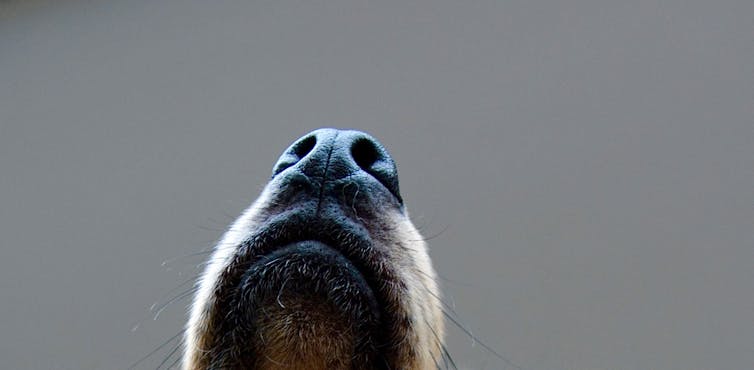From odor to action – how smells are processed in the brain and influence behavior

Esther Kok/EyeEm via Getty Images
John Crimaldi, University of Colorado Boulder; Brian H. Smith, Arizona State University; Elizabeth Hong, California Institute of Technology, and Nathan Urban, Lehigh University
A dog raises its nose in the air before chasing after a scent. A mosquito zigzags back and forth before it lands on your arm for its next meal. What these behaviors have in common is that they help these animals “see” their world through their noses.
While humans primarily use their vision to navigate their environment, the vast majority of organisms on Earth communicate and experience the world through olfaction – their sense of smell.
We are members of Odor2Action, an international network of over 50 scientists and students using olfaction to study brain function in animals. Our goal is to understand a fundamental question in neuroscience: How do animal brains translate information from their environments to changes in their behaviors?
Here, we trace the interconnections between smells and behaviors – looking at how behavior influences odor detection, how the brain processes sensory information from smells and how this information triggers new behaviors.
Detecting odors in the environment
When the odor of a flower is released into the air, it takes the shape of a wind-borne cloud of molecules called a plume. It encounters physical obstacles and temperature differences as it flows through space. These interactions create turbulence that splits the odor plume into thin threads that spread out as the scent moves away from its source. These filaments eventually reach an animal’s nose or an insect’s antenna.
Odors that are broken up into filaments present a challenge to animals using them to find food or mates or avoid threats. It becomes difficult to predict precisely where the odor is coming from. Is the source directly ahead, to the left or right, above or below?
To work around this, animals have evolved what are called active sensing behaviors that improve their ability to detect and find odors in the environment.
When a fly detects the smell of fruit or a mosquito detects carbon dioxide from a possible host, for example, both insects first move upwind to get closer to the odor of the food source. They then move in a meandering, back-and-forth motion called casting to find more odor threads before surging upwind again. If they lose the scent, they’ll start casting again until they find the scent. Larger animals, such as mice and dogs, also alternate between more directed movements and more exploratory searching actions.
Animals also move their noses and antennae to improve the chances that they’ll encounter an odor. This is why dogs raise their noses in the air to increase the amount of odor they can sniff, and why insects move their antennae to stir up and penetrate the air to make better contact with odor molecules.
Once information from odors tell the animal that they’re close to the source, visual searching then comes into play.
Making sense of odors
When an animal comes into contact with an odor plume, it detects the presence of these odor molecules through tiny proteins called odorant receptors. These receptors are embedded in the sensory neurons lining its nasal cavity or antennae.
Each sensory neuron contains only one type of odorant receptor. And each type of odorant receptor has a different shape and set of chemical properties that determine which odors can bind to and activate it. Most of these receptors recognize multiple odors, and most odors can bind to multiple different receptors. What encodes the identity of a specific odor in the brain is determined by which combination of receptors are activated, and their relative strength of activation.
An animal like a mouse has about a thousand types of odorant receptors. Having a large number of these receptors with diverse shapes allows the system to detect and distinguish between a very large number of chemically unique odors, including ones the animal has never encountered before. Most odors in the environment are often a mix of many different types of molecules. The smell of some flowers can be a blend of over 100 different chemical compounds.
Once an odor molecule binds to a receptor, sensory neurons send specific electrical signals into compartments of the brain called olfactory glomeruli. Different odors elicit distinct patterns of electrical activity across these regions, and this generates a specific neural representation of the odor in the brain.
An important step toward understanding olfaction is figuring out how different classes of odors map to different patterns of electrical signals in the brain.
Neuroscientists hypothesize that as these signals undergo successive stages of processing deep in the brain, sensory representations of odor are reformatted in ways that extract information most useful to survival. This could be whether the smell is coming from something nutritious, indicating a potential source of food, or it could help the animal identify whether the smell is coming from a potential competitor or predator.
These reformatted sensory representations form the basis for how animals perceive smell and determine what actions they take in response to this information.
From odor to action
Once information about a particular odor reaches the brain, it often elicits both instinctual and learned behaviors. Odors that signal danger may trigger the animal to freeze or run away, while odors from a member of the same species may trigger the animal to mark its territory or initiate courtship.
In many cases, animals perform these tasks with incredible precision and effectiveness. It’s still common to use search dogs to find lost people and pigs to find truffles because available technologies aren’t capable of performing as well.
Animals achieve this level of performance not just because they’re able to detect and identify an odor. They’re also able to integrate odor features, like how intense the odor smells, with environmental clues, like wind direction, and internal cues, like hunger. All this information comes together to generate specific sequences of behaviors such as “face into the wind and then walk forward.”
To understand how odor guides these behaviors, scientists measure or manipulate an animal’s brain activity as they perform specific actions. This is done using imaging, electrophysiology or optogenetics, which selectively activates specific neurons by shining a light on them. These approaches allow researchers to understand how patterns of brain activity shift when an animal changes its behavior to chase after an odor, or how environmental and internal cues combine to produce a best guess on the location of its next meal.
Leading science and technology by the nose
The olfactory system offers a unique opportunity to understand how the brain processes environmental information and translates it to behavior. Compared to other areas of the brain, the olfactory circuit is simpler in structure and uses fewer stages of processing. Its relative simplicity is what allows scientists like us to study it from end to end and learn how the brain works as a whole.

Valery Sharifulin/TASS via Getty Images
Understanding brain function through the lens of olfaction could also pave the way for transformative developments in engineering, neuroscience and public health. Our research should accelerate the development of robots with electronic noses that can use odors to search for chemical weapons,
underwater oil spills
and natural gas leaking from pipelines in environments where it may be tedious or dangerous for humans or animals to go. Robots might also be able to search for missing people or disaster victims, something typically done with trained dogs.
An exciting future in scientific and medical development, we believe, is right under our noses.
[Over 140,000 readers rely on The Conversation’s newsletters to understand the world. Sign up today.]![]()
John Crimaldi, Professor of Civil, Environmental and Architectural Engineering, University of Colorado Boulder; Brian H. Smith, Trustees of ASU Professor, Arizona State University; Elizabeth Hong, Assistant Professor of Neuroscience, California Institute of Technology, and Nathan Urban, Provost and Senior Vice President, Lehigh University
This article is republished from The Conversation under a Creative Commons license. Read the original article.

